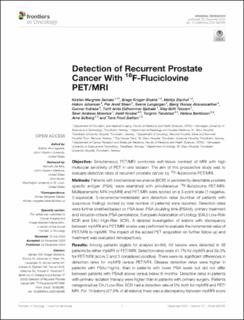| dc.contributor.author | Selnæs, Kirsten Margrete | |
| dc.contributor.author | Krüger-Stokke, Brage | |
| dc.contributor.author | Elschot, Mattijs | |
| dc.contributor.author | Johansen, Håkon | |
| dc.contributor.author | Steen, Per Arvid | |
| dc.contributor.author | Langørgen, Sverre | |
| dc.contributor.author | Aksnessæther, Bjørg Yksnøy | |
| dc.contributor.author | Indrebø, Gunnar | |
| dc.contributor.author | Sjøbakk, Torill Eidhammer | |
| dc.contributor.author | Tessem, May-Britt | |
| dc.contributor.author | Moestue, Siver Andreas | |
| dc.contributor.author | Knobel, Heidi | |
| dc.contributor.author | Tandstad, Torgrim | |
| dc.contributor.author | Bertilsson, Helena | |
| dc.contributor.author | Solberg, Arne | |
| dc.contributor.author | Bathen, Tone Frost | |
| dc.date.accessioned | 2021-04-27T07:57:17Z | |
| dc.date.available | 2021-04-27T07:57:17Z | |
| dc.date.created | 2020-11-23T22:30:56Z | |
| dc.date.issued | 2020 | |
| dc.identifier.citation | Frontiers in Oncology. 2020, 10:582092 1-10. | en_US |
| dc.identifier.issn | 2234-943X | |
| dc.identifier.uri | https://hdl.handle.net/11250/2739790 | |
| dc.description.abstract | Objective: Simultaneous PET/MRI combines soft-tissue contrast of MRI with high molecular sensitivity of PET in one session. The aim of this prospective study was to evaluate detection rates of recurrent prostate cancer by 18F-fluciclovine PET/MRI.
Methods: Patients with biochemical recurrence (BCR) or persistently detectable prostate specific antigen (PSA), were examined with simultaneous 18F-fluciclovine PET/MRI. Multiparametric MRI (mpMRI) and PET/MRI were scored on a 3-point scale (1-negative, 2-equivocal, 3-recurrence/metastasis) and detection rates (number of patients with suspicious findings divided by total number of patients) were reported. Detection rates were further stratified based on PSA level, PSA doubling time (PSAdt), primary treatment and inclusion criteria (PSA persistence, European Association of Urology (EAU) Low-Risk BCR and EAU High-Risk BCR). A detailed investigation of lesions with discrepancy between mpMRI and PET/MRI scores was performed to evaluate the incremental value of PET/MRI to mpMRI. The impact of the added PET acquisition on further follow-up and treatment was evaluated retrospectively.
Results: Among patients eligible for analysis (n=84), 54 lesions were detected in 38 patients by either mpMRI or PET/MRI. Detection rates were 41.7% for mpMRI and 39.3% for PET/MRI (score 2 and 3 considered positive). There were no significant differences in detection rates for mpMRI versus PET/MRI. Disease detection rates were higher in patients with PSA≥1ng/mL than in patients with lower PSA levels but did not differ between patients with PSAdt above versus below 6 months. Detection rates in patients with primary radiation therapy were higher than in patients with primary surgery. Patients categorized as EAU Low-Risk BCR had a detection rate of 0% both for mpMRI and PET/MRI. For 15 lesions (27.8% of all lesions) there was a discrepancy between mpMRI score and PET/MRI score. Of these, 10 lesions scored as 2-equivocal by mpMRI were changed to a more definite score (n=4 score 1 and n=6 score 3) based on the added PET acquisition. Furthermore, for 4 of 10 patients with discrepancy between mpMRI and PET/MRI scores, the added PET acquisition had affected the treatment choice.
Conclusion: Combined 18F-fluciclovine PET/MRI can detect lesions suspicious for recurrent prostate cancer in patients with a range of PSA levels. Combined PET/MRI may be useful to select patients for appropriate treatment, but is of limited use at low PSA values or in patients classified as EAU Low-Risk BCR, and the clinical value of 18F-fluciclovine PET/MRI in this study was too low to justify routine clinical use. | en_US |
| dc.language.iso | eng | en_US |
| dc.publisher | Frontiers | en_US |
| dc.relation.uri | https://www.frontiersin.org/articles/10.3389/fonc.2020.582092/full | |
| dc.rights | Navngivelse 4.0 Internasjonal | * |
| dc.rights.uri | http://creativecommons.org/licenses/by/4.0/deed.no | * |
| dc.title | Detection of recurrent prostate cancer with 18F-Fluciclovine PET/MRI | en_US |
| dc.type | Peer reviewed | en_US |
| dc.type | Journal article | en_US |
| dc.description.version | publishedVersion | en_US |
| dc.source.pagenumber | 1-10 | en_US |
| dc.source.volume | 10:582092 | en_US |
| dc.source.journal | Frontiers in Oncology | en_US |
| dc.identifier.doi | 10.3389/fonc.2020.582092 | |
| dc.identifier.cristin | 1851305 | |
| cristin.ispublished | true | |
| cristin.fulltext | original | |
| cristin.qualitycode | 1 | |

